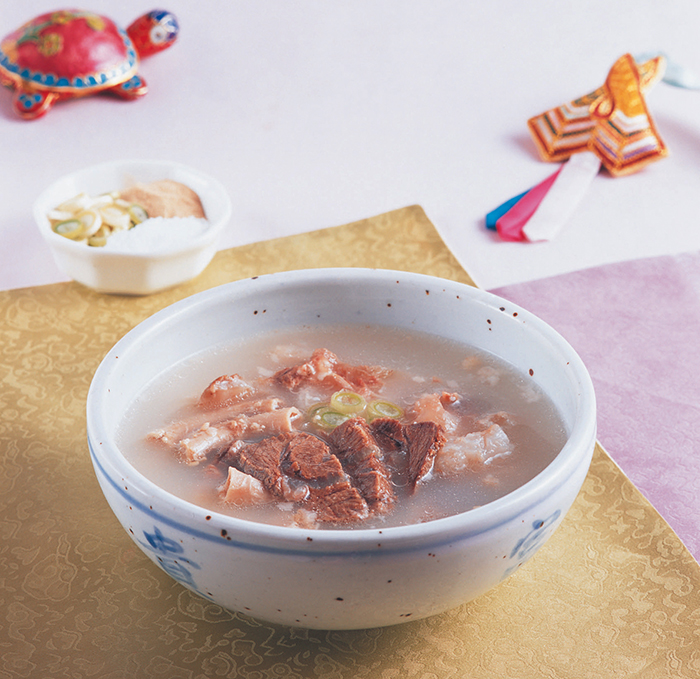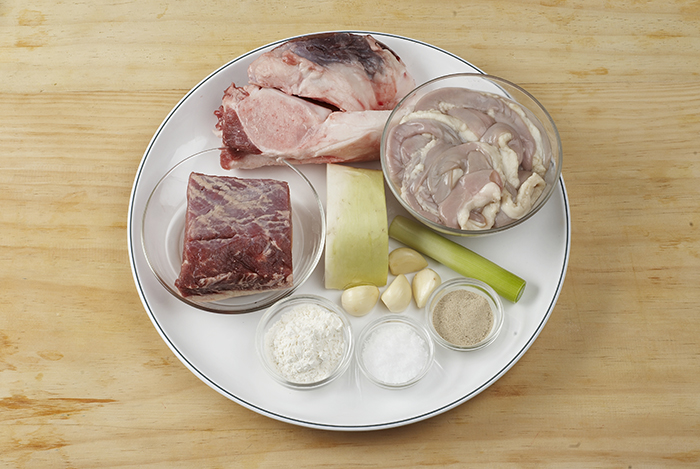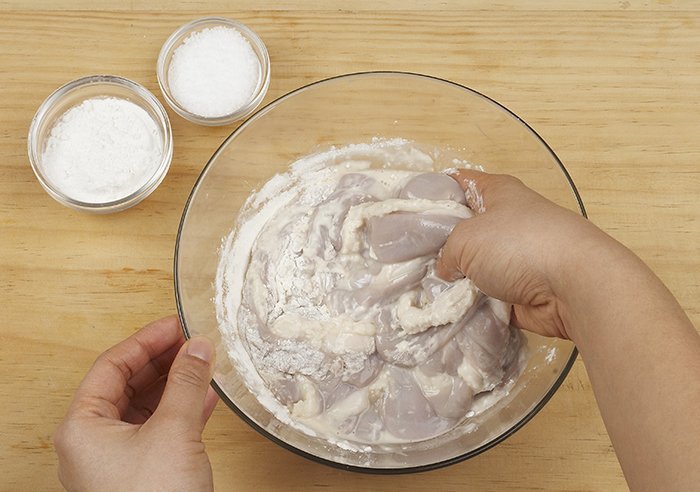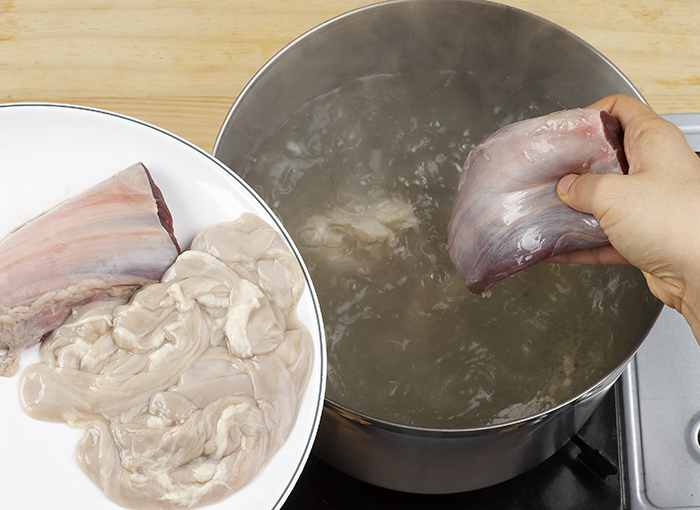As cold weather makes people feel small in the winter, many people would like a warm soup that can soothe their body and mind. Beef broth soup, or gomtang (곰탕), is one such dish that can boost one’s energy and strengthen stamina, not to mention the fact that it’s tasty and nutritious.
To make the dish, you need to boil various parts of a cow in a big pot and boil it with water for many hours. It doesn't require any fancy cooking. When various parts of the cow are boiled for more than 10 hours, however, a deep taste and nutrition from the meat will add more flavor to the soup. The soup doesn't have any unique taste, as it's not sweet, salty, sour, bitter or spicy. However, the soup generates the rich, pure flavor of beef.

Many people get confused between gomtang and ox bone soup or seolleongtang (설렁탕). According to the Institute of Traditional Korean Food, gomtang is a light brown soup boiled with meat parts or inner organs and requires soy sauce to add some taste. Seolleongtang, on the other hand, is a white soup boiled with ox bones. You need to add salt and ground pepper to add some flavor just before eating.
Naju in Jeollanam-do Province and Daegu are some famous regions for this dish. Between the two, Naju gomtang has a lighter broth whereas Daegu gomtang has a darker, yellowish broth.
** Ingredients
300 g beef (shank)
1 knee cartilage of a cow (700 g)
500 g tripe
4 tsp flour (28 g)
2 tbsp salt (24 g)
15 cup water (3 kg)
30 cup water (6 kg)
Fragrant seasoning:
30 g green onion
40 g garlic
1/3 radish (300 g)
1 tbsp salt (12 g)
1/2 tbsp ground pepper (4 g)
20 g green onion

** Preparation
1. Clean any blood from the beef. Put the knee cartilage in water and change the water every hour for three hours to remove any blood.
2. Mix the tripe with flour and salt and clean it in water. Remove any fat.
3. Trim and wash the fragrant seasoning. Trim the green onion and cut it in 0.2 cm slices.

** Recipe
1. Put water to boil over high. When it boils, add the knee cartilage and tripe to the pot for 5 minutes.
2. Put the knee cartilage and water in the pot and boil it over high. When it boils, heat it for 5 more minutes. Lower the heat to medium and boil it for 2 hours. Remove any bubbles or fat that surfaces on the water when boiling.
3. Add the tripe to the pot and boil for 1 hour. Add the fragrant seasoning and beef and boil it all together.
4. When a white broth forms, remove the knee cartilage and remove any flesh from the bone. Cut the tripe into 4 cm pieces. Cut the beef into slices that are 2.5 cm horizontally, 4 cm vertically and 0.3 cm thick. Chill the broth and remove any fat.
5. Put the broth in a pot. Add the beef slices and boil it on high. When it boils, add the salt and ground pepper to taste. Boil it again.
6. Serve the soup in a bowl with green onions as a garnish.

Managed by Yoon Sojung
Korea.net Staff Writer
In cooperation with the Institute of Traditional Korean Food (ITKF)
Content from “The Beauty of Korean Food: 100 Best-Loved Recipes”
arete@korea.kr
To make the dish, you need to boil various parts of a cow in a big pot and boil it with water for many hours. It doesn't require any fancy cooking. When various parts of the cow are boiled for more than 10 hours, however, a deep taste and nutrition from the meat will add more flavor to the soup. The soup doesn't have any unique taste, as it's not sweet, salty, sour, bitter or spicy. However, the soup generates the rich, pure flavor of beef.

Gomtang beef broth soup is made from various cuts of beef. It needs to be boiled in water for many hours to make it delicious. Some people would like to put rice into the soup directly. You can appreciate the deep taste of beef and the chewy taste of the meat.
Many people get confused between gomtang and ox bone soup or seolleongtang (설렁탕). According to the Institute of Traditional Korean Food, gomtang is a light brown soup boiled with meat parts or inner organs and requires soy sauce to add some taste. Seolleongtang, on the other hand, is a white soup boiled with ox bones. You need to add salt and ground pepper to add some flavor just before eating.
Naju in Jeollanam-do Province and Daegu are some famous regions for this dish. Between the two, Naju gomtang has a lighter broth whereas Daegu gomtang has a darker, yellowish broth.
** Ingredients
300 g beef (shank)
1 knee cartilage of a cow (700 g)
500 g tripe
4 tsp flour (28 g)
2 tbsp salt (24 g)
15 cup water (3 kg)
30 cup water (6 kg)
Fragrant seasoning:
30 g green onion
40 g garlic
1/3 radish (300 g)
1 tbsp salt (12 g)
1/2 tbsp ground pepper (4 g)
20 g green onion

The main ingredient for beef broth soup is beef: shin, knee cartilage and tripe. It also needs radish, salt, green onions and garlic.
** Preparation
1. Clean any blood from the beef. Put the knee cartilage in water and change the water every hour for three hours to remove any blood.
2. Mix the tripe with flour and salt and clean it in water. Remove any fat.
3. Trim and wash the fragrant seasoning. Trim the green onion and cut it in 0.2 cm slices.

Mix the tripe with flour and salt and clean it in water. Remove any fat.
** Recipe
1. Put water to boil over high. When it boils, add the knee cartilage and tripe to the pot for 5 minutes.
2. Put the knee cartilage and water in the pot and boil it over high. When it boils, heat it for 5 more minutes. Lower the heat to medium and boil it for 2 hours. Remove any bubbles or fat that surfaces on the water when boiling.
3. Add the tripe to the pot and boil for 1 hour. Add the fragrant seasoning and beef and boil it all together.
4. When a white broth forms, remove the knee cartilage and remove any flesh from the bone. Cut the tripe into 4 cm pieces. Cut the beef into slices that are 2.5 cm horizontally, 4 cm vertically and 0.3 cm thick. Chill the broth and remove any fat.
5. Put the broth in a pot. Add the beef slices and boil it on high. When it boils, add the salt and ground pepper to taste. Boil it again.
6. Serve the soup in a bowl with green onions as a garnish.

Put the broth in a pot. Add the beef slices and boil it all over high. When it boils, add the salt and ground pepper to taste. Boil it again.
Managed by Yoon Sojung
Korea.net Staff Writer
In cooperation with the Institute of Traditional Korean Food (ITKF)
Content from “The Beauty of Korean Food: 100 Best-Loved Recipes”
arete@korea.kr